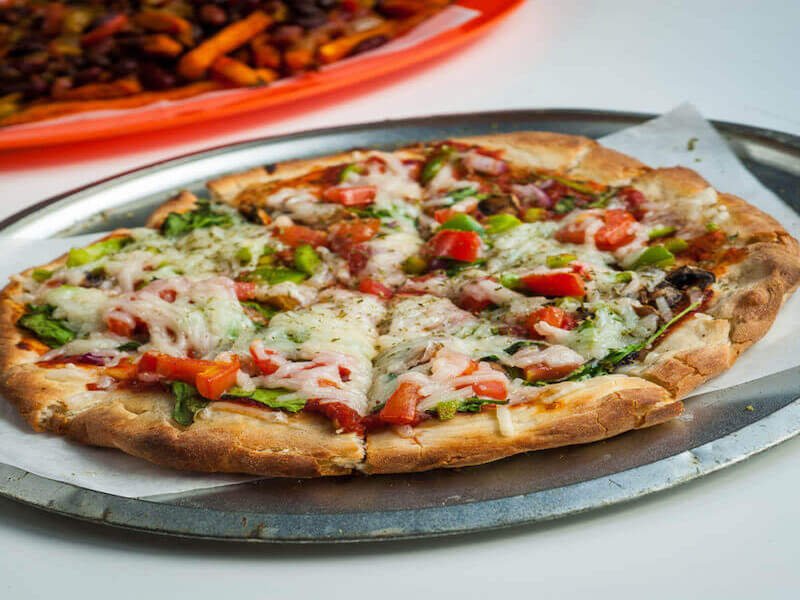The vegan pizza trend is on the rise, and it seems as if everyone is grabbing a slice. From local pizzerias to national chains, vegan pizzas are showing up everywhere.
Not only will a plant-based option make your restaurant more inclusive, but it's also good for business.
According to a study by IMARC, the vegan food market is valued at $17 billion, and it's estimated that plant-based meat sales will increase to $35.5 billion by 2027.
No wonder industry heavyweights are starting to take notice. For instance:
Pizza Hut has an entire vegan menu.
You can pick up vegan pepperoni at Trader Joe's.
Double Zero (a fully vegan pizza chain) has multiple locations nationwide.
There are many ingredient options when it comes to building a vegan pizza. So before putting this trendy new creation on your menu, make sure you know what the people want.
Below you'll find our recommendations for vegan pizza toppings based on what some of our restaurant partners have on their menus.
But First, What Is Vegan Pizza?
Vegan pizza is exactly what it sounds like: a pie made with vegan ingredients. That means no dairy, eggs, or animal products of any kind.
Pizza dough is often naturally vegan, as the basic ingredients are just flour, water, yeast, and salt.
However, if your restaurant uses an enriched dough, like brioche, then you will need to experiment with an alternative dough recipe.
Photo courtesy of Piante Pizzeria.
Your food service provider has many different kinds of plant-based cheeses and meats. These ingredients are usually embraced by vegans and those looking to reduce their meat and dairy intake.
Vegan Pizza Toppings
While the crust and sauce are the supporting components of a great pie, the toppings are the stars.
Vegan Cheese
There are a few ways to make a cheese-like ingredient that is still melty and delicious.
The main components of vegan cheese are usually simple, for example, nutritional yeast, cashews, olive oil, lemon juice, and seasonings.
Cashew is the most popular option for a cheese alternative, but if you want to cater to people with nut allergies, here is a recipe for a nut-free "cheese."
Photos courtesy of Bakaris Plant Based Pizza.
Vegan cheese made from cashews is good because it melts really well. Like traditional cheese, "cheese" with a cashew base will get brown and bubbly. If you do it well, you might even dupe some of your omnivore customers.
Want another option?
Try experimenting with vegan cashew ricotta. Like regular ricotta cheese, vegan ricotta doesn't melt the way that most dairy-based cheeses do, but it has an interesting flavor profile and tastes delicious on top of tomato sauce.
Plant-Based Meaty Options
Pepperoni Substitute
While vegan sausage is great for making pepperoni, some chefs are turning to more creative methods to create a meaty topping option.
Photos courtesy of Gluten Free Pizza Garden.
Some kitchens use firm tofu or tempeh as a base to give customers a hearty yet meatless flavor experience.
Also, keep an eye out for brands that are gluten-free as another value-add to your menu.
Meatless Chicken
Vegan chicken is made from chickpeas or soy and can be fried or baked to mimic chicken. It's a great way to add flavor and texture to your vegan pizzas without all of the cholesterol that comes with animal products.
Some of the best vegan chicken is made from seitan. Pronounced "say-tan," it's a traditional Japanese food made by rinsing the starch away from wheat and keeping the protein.
The result? An impressive meat-like texture with flavor.
From the Garden
For some diners, processed meat and dairy substitutes are not all that appetizing. This is why we suggest topping your pizzas with something that comes from the garden.
Mushrooms are an affordable ingredient that can add a meaty and satisfying taste to a vegan pizza. This tender plant is known for its umami flavor, which provides eaters with an essence of deliciousness. Mushrooms can replace meat in any recipe, especially varieties such as cremini or portobello.
Photo courtesy of Piante Pizzeria.
Jackfruit may look odd on the outside, but this fruit is perfect as a meat substitute for pizza toppings. When roasted, jackfruit has the texture of pulled pork, chicken, or beef! It will absorb the flavor of any marinade or sauce, which makes it a mouthwatering option for vegans!
Cauliflower has a relatively mild and neutral flavor, which is why it works so well as a meatless pizza topping. Smothering roasted cauliflower in buffalo sauce is the most popular way to incorporate cauliflower into a new pizza creation that will satisfy vegans and meat lovers alike.
Artichokes have a slightly nutty flavor, making them a prime stand-in ingredient for meat. Mixing the flavors of spinach, roasted garlic, and artichokes on top of any pizza will leave customers coming back for more. And the best part? Most pizzerias already have artichokes on their specialty pizzas.
Putting All the Ingredients Together
Feeling intimidated by these options because you're not a vegan? You're not alone. It's something that holds a lot of restaurateurs back from experimenting with plant-based options on their menus.
The good news is, there's a solution!
Taste testers.
Reach out to the vegans, vegetarians, and flexitarians in your community. Getting feedback from people who eat these toppings will help you crush the vegan pizza trend and ensure your plant-based options take off in the right direction.
Next, you'll need to entice your customers to try your newest creation.
Offer discounts on your plant-based pizza to incentivize people to give it a try, and hand out samples. It's a no-risk way for your customers to try something new, and you can get feedback while creating some word-of-mouth buzz.
Are you going to make space on your menu for the vegan pizza trend?
Melissa Dimmitt, Marketing Manager
Melissa is the Marketing Manager for Menufy by HungerRush. She began working with restaurant managers and executive chefs over a decade ago, coordinating seasonal menu releases, executing photoshoots, and creating fresh digital content.






